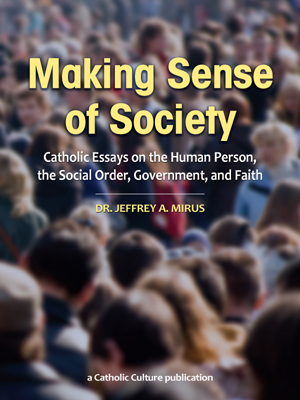Feastday Highlights: The Queenship of Mary
By Jennifer Gregory Miller ( bio - articles - email ) | Aug 19, 2014
The Memorial of the Queenship of Mary on August 22nd is a title of Mary that is more difficult to grasp in this more “democratic” era. Most queens around the world are ceremonial and symbolic and do not rule a county. Revisionist history presents most queens as corrupt or power-hungry. The Blessed Virgin Mary as Queen does not fit any of these descriptions. This is one of the more recent feast days of Mary, established by Pius XII in 1954 for the Universal Church on May 31st. The revision in 1969 of the General Roman Calendar moved it to the eighth or octave day of the solemnity of the Assumption to stress the connectedness of the Blessed Virgin Mary’s Assumption and Queenship.
Free eBook:

|
| Free eBook: Making Sense of Society |
Understanding Mary’s Queenship
Besides reading Pius XII’s encyclical Ad Caeli Reginam (On Proclaiming The Queenship Of Mary), another great explanation on the Queenship of Mary is by Father William Most (the Father William Most Collection is hosted here at Catholic Culture) from his book Mary in our Life. Father systematically explains why there are “inadequate” reasons for proposing Mary’s queenship and then provides the real reasons for her queenship. He cites Pius XII’s encyclical as the main source:
He, the Son of God, reflects on His heavenly Mother the glory, the majesty and the dominion of His kingship, for, having been associated to the King of Martyrs in the ineffable work of human Redemption as Mother and co-operatrix, she remains forever associated to Him, with an almost unlimited power, in the distribution of the graces which flow from the Redemption. Jesus is King throughout all eternity by nature and by right of conquest: through Him, with Him, and subordinate to Him, Mary is Queen by grace, by divine relationship, by right of conquest, and by singular election. And her kingdom is as vast as that of her Son and God, since nothing is excluded from her dominion.7
Father then expands and explains this richness section by section. One of the most difficult thing to understand is that Mary’s Queenship does not exactly echo earthly queenship. She is a Queen Mother, but has dominion and royal power, unlike earthly mothers of queens. And her domain is extensive;. Father Most concludes:
How extensive is Mary’s domain? Pope Pius XII tells us: “And her kingdom is as vast as that of her Son and God, since nothing is excluded from her dominion.” Mary rules over the earth: all graces are distributed through her hands. No request that she makes of her Son, the King, is ever refused. She rules over Purgatory: she prompts the faithful on earth to pray for them. She herself applies to them the fruits of the Redemption earned by both Jesus and herself in co-operation. Her Queenship extends even to Hell. The demons are powerless against her. It is especially humiliating for the devil to be beaten by her, for, although he must rightly expect to suffer defeat at the hands of God Himself, it is galling that a mere creature should also foil him so thoroughly. Finally, her Queenship extends to Heaven itself. All who enjoy Heaven do so by virtue of the graces earned by Jesus and Mary in co-operation, as we have seen. Even the just of the Old Law were saved only in anticipation of the merits of Calvary, in which she co-operated. She also contributes to the accidental blessedness of those in Heaven. For though the essential joy there is the direct vision of God, there is accidental happiness also from the presence of the angels and saints, whose Queen is Mary.
Hence we may say that Mary is Queen of all things,9 without limit to her domain, in the strict sense of the word. Let us thank God for giving us a Queen who is par excellence the “Mother of Mercy.”
Queenship Imagery
Many years ago I watched an obscure black and white movie that helped me understand a bit more of the relationship of a queen to her people. A little orphan peasant boy had many sufferings and had heard that the queen is like a mother to all her subjects. He traveled long and hard to see the queen, thinking she would provide that motherly love he craved. The ending was happy, because he did finally meet the queen and she was most gracious and loving.
I learned afterwards that this was a true portrayal of what a queen is supposed to be and represent. She is to be a mother to her people, concerned for their well-being and caring for their needs.
There is also a parable that portrays a Queen Mother. The petitioner brings an apple to present to the King with his request, but he brings it to the Queen Mother first. She takes the apple, polishes it, arranges it on a beautiful tray, and then she presents it to her Son. The petitioner’s request becomes her own, and the King, because He loves His Mother and can never refuse her, grants the petition.
This is the portrayal of the relationship of Mary and Jesus. To Jesus, through Mary we will have all our needs met.
Continuing Our Lady’s Thirty Days
Because this is a more recent feast, there are no traditional feasts and customs related to this day. Last week I mentioned the old custom of considering August 15 through September 14 as Our Lady’s Thirty Days, during which we continue our focus on Mary during the late summer season. This is also the octave of the Assumption, with these two feasts very interconnected—Mary’s purity and role as Mother of God gives her these privileges of Assumption and Queenship. We can continue our incorporation of first fruits, flowers and herbs.
For families with children, it is easier to visualize the regalness and royalty of the feast day. Foods fit for a queen could be served. Perhaps a very elegant high or royal tea could be planned. Desserts could be in the shape of a crown—either a crown cake, a simple Bundt cake, or even a doughnut gives the visual appearance of a small crown.
Earlier this year I wrote in length about Marian devotion in our family, particularly through music. Regardless of what is offered today, the importance is for us to realize what a wonderful gift we have with Mary as our Queen and Mother, and to remember to turn to her often. The “Hail Holy Queen (Salve Regina)“ prayer sums it up well:
Hail, holy Queen, Mother of mercy; hail our life, our sweetness and our hope. To you do we cry, poor banished children of Eve. To you do we send up our sighs, mourning and weeping in this valley of tears. Turn then, most gracious Advocate, your eyes of mercy toward us. And after this our exile show unto us the blessed fruit of your womb, Jesus. O clement, O loving, O sweet Virgin Mary.
All comments are moderated. To lighten our editing burden, only current donors are allowed to Sound Off. If you are a current donor, log in to see the comment form; otherwise please support our work, and Sound Off!







